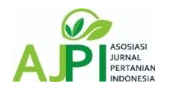Respon Pertumbuhan Dan Produksi Bawang Merah (Allium Cepa. L.) Akibat Pemberian Asam Humat Dan Npk 16:16:16
DOI:
https://doi.org/10.58794/juragan.v1i1.466Keywords:
Humic acid, NPK fertilizer, shallotsAbstract
The shallot plant is an important vegetable commodity because it contains high nutrition, raw material for medicines, and as a complement to cooking spices, and has many vitamins and acts as an enzyme activator in the body. Shallot production, especially in Riau Province, is still not sufficient for the people's needs. The low production yield is due to low soil fertility and sub-optimal cultivation methods. For this reason, efforts are needed to increase shallot yields in Riau Province. In order for the land to be productive, it is necessary to make efforts to improve it by adding ameliorants, which are materials that can increase soil fertility by improving the physical, chemical and biological conditions of the soil. The purpose of this study was to determine the effect and obtain the best dose of Humic Acid, NPK Mutiara 16:16:16 fertilizer, and its interaction on the growth and production of shallots. This research was carried out experimentally using a factorial Completely Randomized Design (CRD), which consisted of two factors, namely H (Humic Acid) which consisted of 3 levels, and factor N (NPK fertilizer) which consisted of 3 levels, and each of them had 3 repetitions, the number of experimental units is 27 plots, each plot consists of 3 plants and 2 plants as samples, so the number of plants is 27x3 = 81 plants. The parameters observed were as follows: "Plant Height" (cm), "Number of Leaves" (strands), "Number of tubers (cm2), Diameter of tubers (cm), Number of tubers (fruits) and Weight of tubers (grams). And the interaction of humic acid and NPK fertilizer with doses of H2N2 (giving 2 g/polybag of humic acid and 20 g/polybag of NPK) gives the best results.
References
Ariawan, A. Thata, R. Prahastuti, S.W. 2016. Pemetaan status hara kalium pada tanah sawah di Kecamatan Balinggi, Kabupaten Parigi. Sulawesi Tengah. J. Agrotekbis. 4(1): 43-49.
Azmi, C., I.M. Hidayat. G. Wiguna. 2011. Pengaruh varietas dan ukuran umbi terhadap produktivitas bawang merah (Allium cepa L). J. Hort. 21(3): 206-213.
Firmansyah, I. Khaririyatun, L.N,. Yufdy. 2015. Pertumbuhan dan hasil bawang merah dengan aplikasi pupuk organic dan pupuk hayati pada tanah alluvial. Bandung Barat. Balai penelitian tanaman sayuran. J. Hort. Vol 25 no 2
Goenadi, D. H. 2006. Pupuk dan Teknologi Pemupukan Berbasis Hayati.Dari Cawan Petri ke Lahan Petani. Yayasan Idedtama. Jakarta.
Jones, JB. Wolf, B dan Milss, HA. 1991. Plant analysis hand book, Micro-macro Publishing. Inc.
Lestari dan Azwin. 2014, Pengujian Pupuk Tulang Ayam Sebagai Bahan Amelioranasi Terhadap Pertumbuhan Tanaman Sorghum dan Sifat-sifat Kimia Tanah Podzolik Merah Kuning Pekanbaru. J. Ilmiah Pertanian. 11(2). 35-42
Leiwakabessy, F.M. 1988. Kesuburan Tanah. IPB Press. Bogor.
Naingolan. 2010. Pola Pelepasan Nitrogen dari Pupuk Tersedia Lambat (Slow Realase Fertilizer). [Skripsi]. Institut Pertanian Bogor. Bogor.
Napitupulu, D. Dan L. Winarto. 2009. Pengaruh Pemberian Pupuk N dan K Terhadap Pertumbuhan dan Produksi Bawang Merah, Medan.
Novizan. 2002. Petunjuk Pemupukan Yang Efektif . AgroMedia. Tanggerang
Nursyamsi, D. M.T. Sutriadi. 2006. Penelitian uji tanah hara kalium di tanah Inceptisol untuk kedelai (Glicyne max L). Jurnal Tanah Trop. 1: 1-9.
Ponnamperuma. 1978. Electrochemical changes in submerged soils and the growth of rice. Pp 421-439. In Soils and Rice. The International Rice Research Institute. Los Banos, Laguna. Fhilippines Prihmantoro.H. 2007. Memupuk Tanaman Sayur. Penebar Swadaya. Jakarta.
Putrasamedja, S. Suwandi. 1996. Varietas Bawang Merah Indonesia. Pusat Penelitian dan Perkembangan Holtikultura. Badan Penelitian dan Perkembangan Pertanian.
Putro, B. P. Samudro, G. Nugroha, W. D. 2016. Pengaruh penambahan pupuk NPK dalam pengomposan sampah organic secara aerobic menjadi kompos matang. J. Teknik Lingkungan. 5(2): 15-25
Rizqiani, N.F.E. Ambarwati. N.W. Yuwono. 2007. Pengaruh Dosis Dan Frekuensi Pemberian Pupuk Organic Cai Terhadap Pertumbuhan Dan Hasil Buncis (Phaseolus Vulgaris L) Daratan Rendah. J. Ilmu Tanah Dan Lingkungan. 7(1):43-53.
Samadi,. Cahyono. 2000. Identifikasi Budidaya Bawang Merah. Kanisius. Yogyakarta
Simanulangkit, P. Jasmani. G. Simanulangit. T. 2012. Respon Pertumbuhan dan Produksi Tanaman Melon (Cucumis melo L) terhadap Kombinasi Biodegradable Super Absorbat Polimer dengan pupuk majemuk NPK ditanah miskin. Agrium. 17(3):155-162.
Sutedjo, M.M. dan A.G. Kartaspoetra. 2002. Pengantar Ilmu Tanah. Rineka Cipta. Jakarta
Tambunan, E. R. 2009. Respon pertumbuhan bibit kakao (Theobroma cacao L) pada media tumbuh sobsoil dengan aplikasi kompos limbah pertanian dan pupuk anorganik. Tesis. Fakultas Pertanian USU. Medan.









